Okboev Toshpulat Alikhuzhaevich
Ministry of Health of the Republic of Uzbekistan, Candidate of Medical Sciences, Senior Lecturer, Department of Internal Medicine No. 4, Samarkand State Medical University, Samarkand, Uzbekistan
Correspondence to: Okboev Toshpulat Alikhuzhaevich, Ministry of Health of the Republic of Uzbekistan, Candidate of Medical Sciences, Senior Lecturer, Department of Internal Medicine No. 4, Samarkand State Medical University, Samarkand, Uzbekistan.
| Email: |  |
Copyright © 2024 The Author(s). Published by Scientific & Academic Publishing.
This work is licensed under the Creative Commons Attribution International License (CC BY).
http://creativecommons.org/licenses/by/4.0/

Abstract
The article discusses the importance of cytokines total IgE and IL-6, IFN-γ in the development of additional criteria for early diagnosis, prognosis and management of the disease in a family of patients with familial bronchial asthma of Uzbek nationality. The study was conducted on 265 individuals from 49 families with a genetic predisposition to bronchial asthma. Total IgE, IL-6 and interferon-g were tested in blood serum by IEA using the Vector-Best test system. Analysis of the level of total IgE, IL-6 and interferon-g in the blood serum of individuals with a hereditary predisposition to familial bronchial asthma was carried out depending on the pathogenetic type of bronchial asthma, step of the disease, duration of the disease and severity. disease control. It is shown that various manifestations of familial bronchial asthma, steps, types, duration of the disease, as well as the levels of total IgE, IL-6 and interferon-g at the control level of the disease can be used as additional evaluation criteria. diagnostics, prognosis and treatment of the disease are indicated.
Keywords:
Familial bronchial asthma, Total IgE, IL-6, Interferon-g, Early diagnosis, Prognosis, Criterion
Cite this paper: Okboev Toshpulat Alikhuzhaevich, The Role of Cytokines as Additional Criteria for Diagnosis, Prognosis and Management of Patients with Familial Bronchial Asthma, American Journal of Medicine and Medical Sciences, Vol. 14 No. 12, 2024, pp. 3200-3206. doi: 10.5923/j.ajmms.20241412.23.
1. Introduction
Studying the role of cytokines in the pathogenesis of various diseases is one of the newest areas of modern medicine [1,9,10,11]. Cytokines play an important role in the process of antigen activation and enhance the ability of INF-γ macrophages to present allergens [12,13,14]. Macrophages are the source of the first wave of IL-6 cytokines. Determining the concentration of cytokines in the blood and other body fluids has prognostic significance [2,3]. In order to assess the severity of the disease and predict its course, the concentration of pro-inflammatory and anti-inflammatory cytokines in the dynamics of the disease is determined. In recent years, significant progress has been made in understanding the role of certain cytokines in human health and disease through the development of methods for measuring levels of cytokine production [4,5,6,7,8]. A number of studies have been conducted to study serum cytokines in patients with bronchial asthma (BA). An increase in the level of a number of cytokines in the blood serum was confirmed [1,3,10,12,15,16,17]. However, some authors do not have reliable data on the relationship between the level of cytokines in the blood serum and the progression of the disease. In particular, there is insufficient information about the importance of cytokines as criteria for diagnosing familial bronchial asthma, predicting the course of the disease and determining the degree of control.Therefore, the role of immunological tests in the study of diagnosis, prognosis and management tactics with a hereditary predisposition to familial bronchial asthma in the Uzbek population is important.Purpose of the study. To study the importance of common cytokines IgE and IL-6, IFN-γ in the development of additional criteria for early diagnosis, prognosis and management tactics in the family of patients with familial bronchial asthma in the Uzbek population.
2. Materials and Methods of Research
The level of total IgE and IL-6, interferon-g in the blood serum of patients with bronchial asthma was studied in 49 families with a hereditary predisposition to familial bronchial asthma. Family members included in the study were divided into 2 groups:1) Relatives with bronchial asthma (82/265 – 30.94%);2) Healthy relatives in the family (183/265 -69.06%).The study included 265 family members aged from 10 to 67 years (average 37.04 years), of which 125 (47.17%) were men and 140 (52.83%) women.In order to establish the disease of bronchial asthma in the family, all persons in the family underwent a comprehensive clinical, functional and laboratory examination. The examination of patients was carried out in accordance with the diagnostic criteria of the WHO international classification (based on the revised ICD-10) and the global strategy for the treatment and prevention of asthma (GINA, 2022).Immunological analyzes of family members were carried out in the laboratory of the Institute of Immunology and Immunodiagnostics of the Academy of Sciences of the Republic of Uzbekistan. The levels of INF-γ and IL-6 in blood serum were determined by IEA.In the control group, 21 (11 men and 10 women) healthy individuals aged 17-62 years (average 28.64) were examined.The results of statistical processing of the obtained data were carried out using the Microsoft Excel program on the Rentum-IV computer.
3. Result
Initially, immunological examination was carried out in patients diagnosed with bronchial asthma from the individuals selected for the study in the family. Analyzing the obtained results, it can be said that the parameters of inflammatory and anti-inflammatory cytokines in patients with familial BA show an increase in total IgE, IL-6 and interferon-g producing immunocomponent cells in blood serum. Total IgE, IL-6 and interferon-γ levels in the peripheral blood serum of patients with familial BA (respectively 295.94±21.91 IU/ml; 13.83±0.98 pg/ml; 7.07±0, up to 40 pg/ml) was reliably increased from the indicator in the control group (67.2±16.44 ME/ml; 8.6±2.4; 4.4±0.8 pg/ml, respectively) ( respectively r<0.001, p<0.01, p<0.05) (Fig. 1).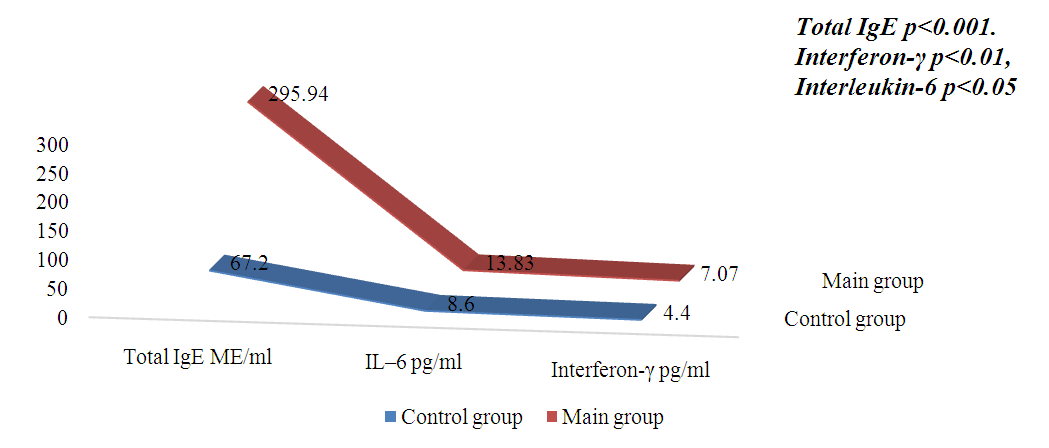 | Figure 1. Indicators of total IgE, IL-6 and interferon-g in the blood serum of patients with bronchial asthma in the family |
Based on the results of immunological examination of patients, the level of production of total IgE, IL-6 and interferon-g in the peripheral blood serum of patients with pathogenetic types of familial BA was studied. In this case, the amount of total IgE, IL-6 and IFN-g in peripheral blood serum of patients with allergic type of familial BA (respectively 564.2±72.04 ME/ml; 18.3±1.3 pg/ml; 5, 1±0.12 pg/ml) from the control group (67.2±16.44 ME/ml; 8.6±2.4 pg/ml; 4.4±0.8 pg/ml, respectively) statistically reliable increase was noted (r<0.001, r<0.05).The amount of total IgE, IL-6 and IFN-γ in peripheral blood serum of patients with nonallergic type of familial BA (respectively 156.4±21.5 ME/ml; 11.3±1.06 pg/ml; 8.9 ±1.08 pg/ml) reliably increased from the control group (67.2±16.44 ME/ml; 8.6±2.4 pg/ml; 4.4±0.8 pg/ml, respectively) was noted (r<0.01, r<0.05).The amount of total IgE, IL-6 and IFN-γ in peripheral blood serum of patients with mixed type of familial BA (312.9±44.23 ME/ml; 14.8±1.23; 7.87±1, respectively) 28 pg/ml) was found to be reliably higher (r<0.001) than the control group (67.2±16.44 ME/ml; 8.6±2.4; 4.4±0.8 pg/ml, respectively), r<0.05) [Fig. 2].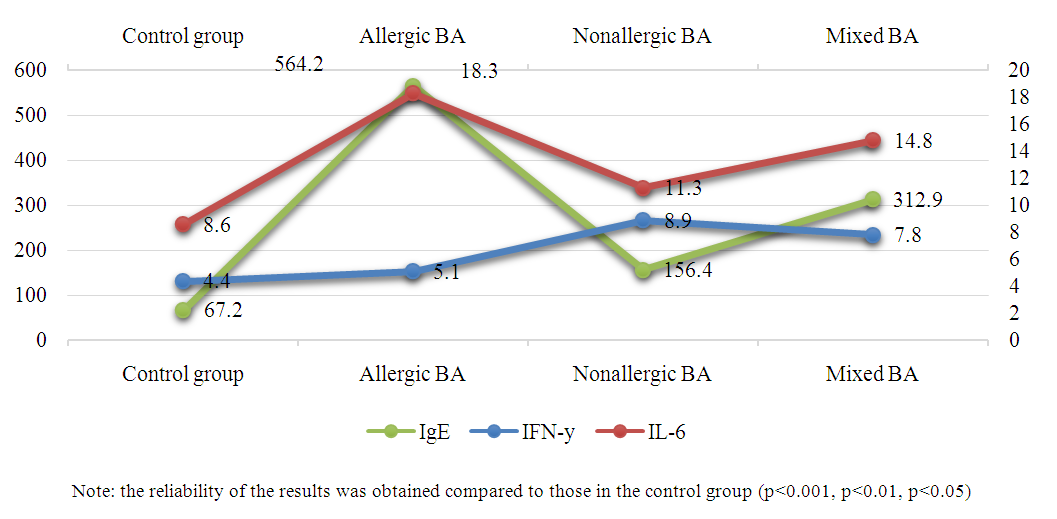 | Figure 2. Indicators of total IgE, IL-6 and interferon-g in clinical-pathogenic types of bronchial asthma |
The study of the level of IgE, IL-6 and IFN-γ products in patients with familial BA showed that the amount of inflammatory IgE and cytokines in the peripheral blood was high, regardless of the pathogenetic types of the disease. The amount of IgE, IL-6 and IFN-γ in peripheral blood serum is allergic (564.2±72.04 ME/ml; 18.3±1.3 pg/ml; 5.1±0.12 pg/ml, respectively), nonallergic (respectively 156.4±21.5 ME/ml; 11.3±1.06 pg/ml; 8.9±1.08 pg/ml) and mixed (respectively 312.9±44.23 It was noted that there was a statistically significant difference (p<0.001, p<0.05) in ME/ml; 7.87±1.28 pg/ml. This information about the immunological mechanisms in the pathogenesis of familial BA can be the basis for recommending a new differentiated approach to diagnosis and pathogenetic treatment that stops the development of inflammatory diseases of the respiratory tract. The highest index of total IgE detected in the peripheral blood serum in the allergic type of the disease (564.2±72.04 ME/ml) confirms that it is an early diagnostic immunological marker. Compared with other types of the disease in the family BA allergic type, it was shown that the increase in the amount of IL-6 in the peripheral blood serum of patients, and the decrease in the amount of interferon-g are comparative diagnostic markers for distinguishing pathogenetic types of the disease.The immunological indicators of patients with BA in the family were evaluated according to the steps of the disease. Total IgE, IL-6, and IFN-γ levels in peripheral blood serum were significantly increased in patients with all steps of the disease according to the severity of familial BA. Disease in step I (respectively 311.1±32.4 ME/ml; 18.2±2.9 pg/ml; 7.2±1.1 pg/ml) in the control group (respectively 67.2±16.44 ME/ml; 8.6±2.4; 4.4±0.8 pg/ml), in step II (respectively 262.6±21.3 ME/ml; 17.7±2,1 pg/ml; 7.8±0.9 pg/ml) in the control group (67.2 ±16.44 ME/ml; 8.6±2.4; 4.4±0.8 pg/ml, respectively), in step III (respectively 171.6±18.6 ME/ml; 14.5±2.7 pg/ml; 8.9±1.4 pg/ml) in the control group (respectively 67.2 ±16.44 ME/ml; 8.6±2.4; 4.4±0.8 pg/ml), in step IV (respectively 132.3±12.7 ME/ml; 12.3±1,9 pg/ml; 9.6±1.2 pg/ml) in the control group (67.2 ±16.44 ME/ml; 8.6±2.4; 4.4±0.8 pg/ml, respectively) it was found that the indicators were recorded (p<0.001, p<0.01, p<0.02, p<0.05) [Figure 3].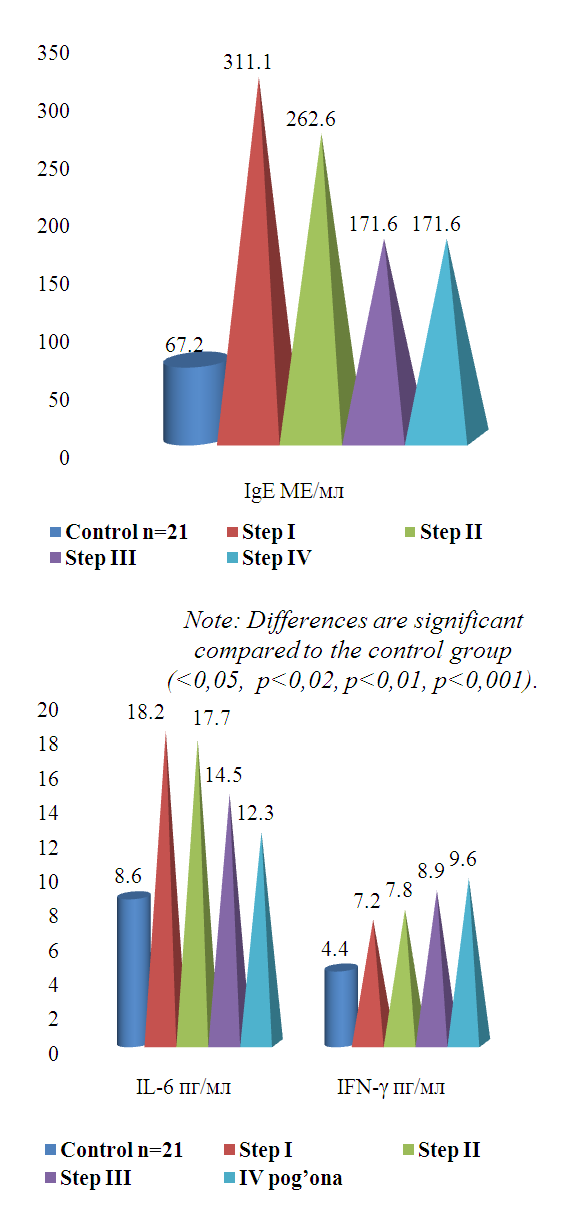 | Figure 3. Indicators total IgE, IL-6, and interferon-γ according to the severity of bronchial asthma in the family |
Thus, in patients with familial BA, with increasing stages of the disease, it was observed that the amount of total IgE and IL-6 in the blood serum of the patient decreased, but the amount of IFN-γ increased. Such indicators of total IgE, pro-inflammatory and anti-inflammatory cytokines, which are considered as a criterion for allergic inflammation, can be evaluated as markers of the severity of the disease in familial BA. In familial BA, it can be explained that as a result of deficiencies in the immune system, it causes the development and severity of the disease. This shows that it is a criterion for timely diagnosis of the disease and determining treatment tactics.In the research conducted by us, it was observed that as the duration of the disease identified in the family increases, the disease becomes more severe and the rate of remission increases. For this reason, the analysis of the immunological indicators determined in patients with familial BA was carried out according to the duration of the disease. As the duration of the disease increased, it was noted that the amount of total IgE, IL-6 and IFN-g in the peripheral blood serum of patients significantly increased.In patients with familial BA, the amount of total IgE in peripheral blood serum up to 5 years - 304.2 ± 24.9 ME/ml, 5-10 years - 271.6 ± 26.7 ME/ml, 10-15 years - 189.4 ±25.8 ME/ml, over 15 years - 172.7±22.4 ME/ml, compared to the control group - 67.2± 16.44 ME/ml, it was observed a reliable increase (p<0.001).In patients with familial BA, the amount of IL-6 in peripheral blood serum up to 5 years - 16.2±1.9 pg/ml, 5-10 years - 15.4±2.1 pg/ml, 10-15 years - 14, 6±1.3 pg/ml, over 15 years - 13.1±2.9 pg/ml, compared with the control group - 8.6±2.4 pg/ml, a statistically significant difference was observed (p<0.02, p<0.05).In patients with familial BA, the amount of IFN-g in the peripheral blood serum of disease duration up to 5 years - 6.0 ± 0.9 pg/ml, 5-10 years - 6.4 ± 1.2 pg/ml, 10-15 years - 7, There was a significant difference in the values of 2±0.7 pg/ml, compared to the control group - 4.4±0.8 pg/ml. Only in the period of more than 15 years - 8.4 ± 1.4 pg/ml, a reliable difference was noted (p<0.05) [Figure 4].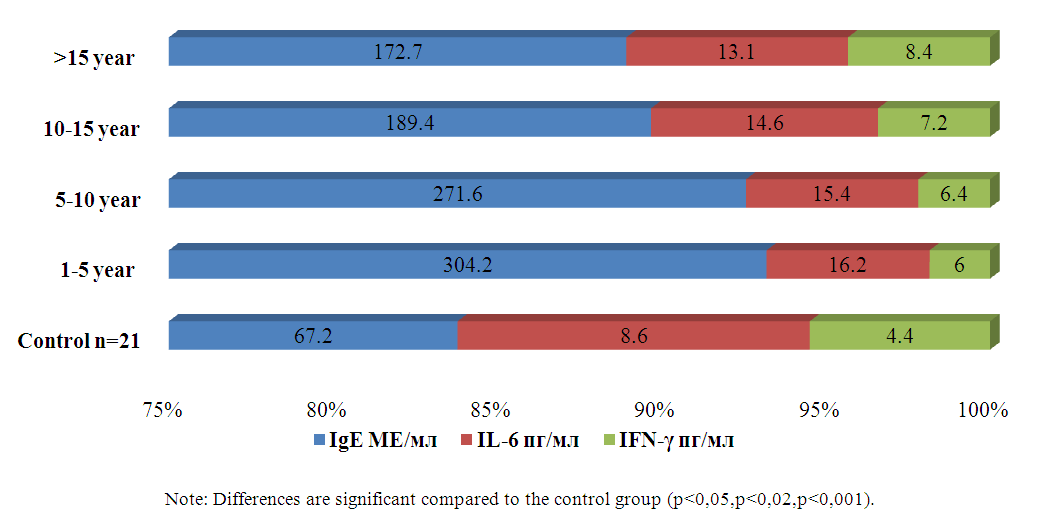 | Figure 4. Indicators total IgE, IL-6, and interferon-γ in familial bronchial asthma according to disease duration |
The obtained results revealed that the study of immunological mechanisms in the pathogenesis of familial BA, i.e. the role of general IgE, IL-6 and IFN-γ is of great importance in the development and continuation of the inflammatory process of the respiratory tract in this pathology.Immunological parameters determined in patients with familial BA were evaluated according to the level of disease control. The amount of total IgE in peripheral blood serum was significantly increased in patients with familial BA who did not reach control (456.7±32.8 ME/ml) compared to control patients (243.4±29.3 ME/ml) (p<0.001). Compared to the control group, the total IgE content (67.2±16.44 ME/ml) was found to be significantly different in both groups (p<0.001).The amount of IL-6 in peripheral blood serum was significantly increased in patients with familial BA who did not achieve control (15.7±2.3 pg/ml) compared to control patients (9.6±1.9 pg/ml) (p<0.05). It was found that the amount of IL-6 in the control group (8.6±2.4 pg/ml) was reliably increased compared to the control group (p<0.05). It was noted that the amount of IFN-γ in peripheral blood serum was significantly decreased in patients with familial BA who did not achieve control (3.5±0.8 pg/ml) compared to patients who achieved control (4.8±0.9 pg/ml). The amount of IFN-γ in the control group was 4.4±0.8 pg/ml [Figure 5].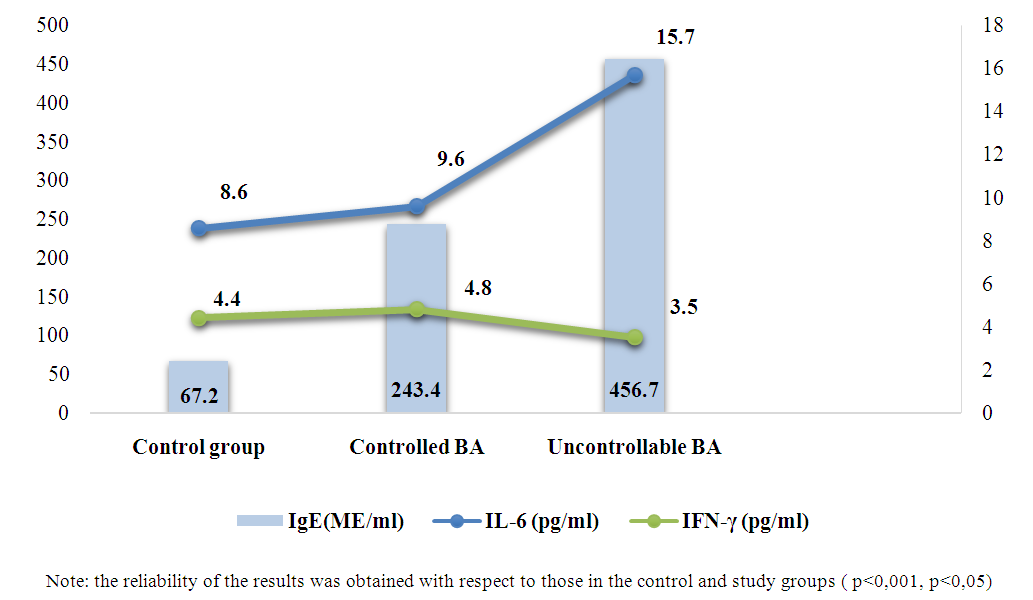 | Figure 5. Indicators total IgE, IL-6, and interferon-γ in the control of bronchial asthma in the family |
The study of the level of total IgE and IL-6 showed that their content in the peripheral blood was high regardless of the period of disease control and uncontrolled (p<0.001). It was noted that the amount of IFN-g was significantly reduced in those who did not achieve disease control. Thus, these indicators of cytokine products in the control of the disease were explained as the basis for a new approach to diagnosis.It is known from the literature that the change in the immunological state of the body is one of the main causes of BA pathogenesis. IgE and cytokines, which are immunological markers of inflammation, depend on the level of expression, the stage of the disease and the severity of the disease. The research is of great importance in studying the immunological status of individuals in the family, diagnosis, treatment and prevention. Individuals from the family selected for examination were divided into the following groups (proband, relatives with familial BA, and healthy individuals), and total IgE, IL-6, and IFN-γ levels were analyzed. The amount of total IgE in peripheral blood serum was 304.2±24.9 ME/ml in family probands, 271.6±26.7 ME/ml in relatives with BA, and 189.4±25.8 ME/ml in relatives without BA. made ml. It was noted that the value of the immune indicators of these examined groups in the family was statistically reliably higher when compared with the control group - 67.2±16.44 ME/ml (p<0.001). The amount of IL-6 in peripheral blood serum in probands - 16.2±1.9 pg/ml, relatives with BA - 15.4±2.1 pg/ml, relatives without BA - 14.6±1.7 pg/ml organized the In comparison with the indicator of the control group - 8.6±2.4 pg/ml, it was expressed as a reliable increase in all the above groups (p<0.02, p<0.05). The amount of IFN-γ in peripheral blood serum was 7.1±1.2 pg/ml in probands, 5.1±0.9 pg/ml in relatives with BA, 4.8±0.8 pg/ml in relatives without BA. organized. In the control group, this indicator was recorded - 4.4±0.8 pg/ml [Fig. 6].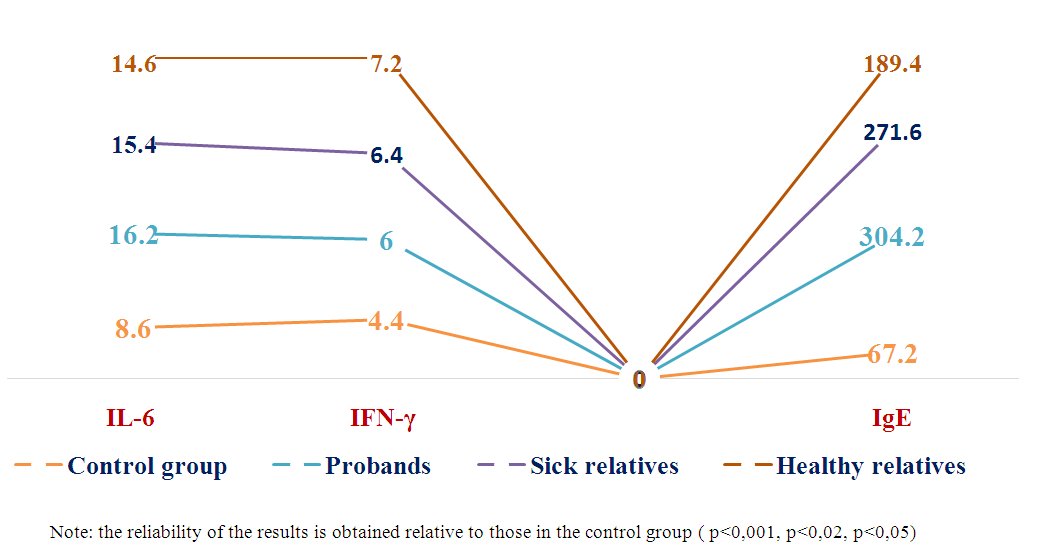 | Figure 6. Indicators total IgE, IL-6, and interferon-g levels in individuals grouped in a family |
Thus, total serum IgE levels were reliably elevated in all family groups examined, including probands, relatives with BA, and relatives without BA (p<0.001). These sources confirm that the development of IgE-mediated mechanism plays a key role in the development of allergic inflammation in familial BA, and indicate the presence of an allergic background in relatives without BA. This is important in predicting the course of the disease. The values of IL-6 and IFN-γ in the blood serum of the patients in the family show that they correspond to the stages of the disease and are inflammatory biomarkers, showing their importance in the diagnosis of the disease.Correlation of IgE, IL-6 and IFN-γ indicators was studied in the groups where the family study was conducted.In patients with familial BA, there is a statistically correct relationship between the pathogenetic types of the disease and the concentration level of IgE-IL-6 in all groups of patients, in the general group r=0.64; p<0.01, r=0.74 in allergic type; p<0.01 has a positive correlation, in non-allergic type r=0.11; p<0.05, r=0.25 in mixed type; It was found that p<0.05 has a weak positive correlation.In patients with familial BA, there is a statistically inverse relationship between the pathogenetic types of the disease and the concentration level of IL-6-IFN-γ in all groups of patients, r=-0.33 in the general group; p<0.02, r=-0.21 in allergic type; p<0.05, r=-0.41 in non-allergic type; p<0.02, it was found that there is a negative weakly expressed correlation relationship, no correlation relationship was observed in the mixed type.In patients with familial BA, there is a statistically inverse relationship between pathogenetic types of the disease and the level of IgE - IFN-g concentration in all groups of patients, r=-0.34 in the general group; p<0.02, r=-0.30 in allergic type; p<0.02, there is a weakly expressed correlation relationship, in the mixed type r= 0.22; p<0.05 was noted to have a weak positive correlation, and no correlation was observed in the non-allergic type.The results of the conducted correlation analysis show that the production of cytokines in different pathogenetic forms of BA is unique. The table shows that interleukins are involved in the types of pathology, in patients with all types of the disease, IgE-IL-6 is more involved, IL-6-IFN-g and IgE-IFN-g are slightly less involved.Table 1. Correlation of IgE, IL-6 and IFN-γ indicators in the studied groups
 |
| |
|
4. Conclusions
Thus, the result of studying the immunological status of patients with familial BA showed that the highest index of total IgE detected in blood serum is observed in the allergic type of the disease, confirming that this is a diagnostic immunological marker. In patients with familial BA, total IgE and IL-6 levels in the patient's blood serum decrease with increasing stages of the disease, but IFN-g levels increase, and total IgE and IL-6 levels in the patient's blood serum decrease with increasing disease duration., showed that the increase in the amount of IFN-γ is a criterion for timely diagnosis of the disease and determining treatment tactics. Also, the high level of total IgE in relatives without BA was explained by the fact that they have an allergic background.Studies have shown that patients with familial BA have immunodeficiency associated with abnormalities in immune system activity and cytokine status. It can be said that these are the basis for comparative diagnosis of different manifestations and degrees of BA disease in the family, a new approach to its pathogenesis, and the creation of a coordinated treatment plan based on this.
References
| [1] | Aralov N. R. et al. The role of the polymorphic locus of the eNOS3 gene and their relationship of anti- and pro-inflammatory cytokines in familial bronchial asthma // Achievements of science and education. - 2019. - No. 9-1 (50). - P. 34-39. |
| [2] | Aralov N. et al. Study of the spectrum of anti- and pro-inflammatory cytokines in blood serum in familial bronchial asthma // Journal of Problems of Biology and Medicine. - 2017. - No. 3 (96). - P. 24-26. |
| [3] | Aralov N. R., Okboev T. A., Davidyan A. A., Kholliev R. Kh., Klebleeva G. D., Ziyadullaev Sh. Kh. Production of immunoregulatory cytokines IL-6, IFN-γ and IgE in various pathogenetic types of bronchial asthma. BULLETIN of the Central Asian Pulmonologists Association. Tashkent 2013, issue 16 (No. 1-4). Pp. 53-56. |
| [4] | Drygina LB, Alkhutova NA Production of immunoglobulins of class E in patients with atopic allergy. // Medical Immunology. - 2002. - V. 4, No. 2, - P. 175. |
| [5] | Dugarova ID, Anaev EH, Chuchalin AG On the role of cytokines in bronchial asthma // Pulmonology. - 2009. - No. 4. – P. 96-102. |
| [6] | Okboev T.A., Dusanov A. D. The significance of indicators of the function of external respiritation in the early detection of bronchial asthma in the family. //Journal of environmental health research. Volume 1 Issue 2 2022. page no.: 57-63. |
| [7] | Okbaev T. A. Safarova M.P. Prevalence of eNOS 3 Gene Polymorphism in Family Members of Patients with Familial Bronchial Asthma in the Uzbek Population. American Journal of Medicine and Medical Sciences. 213(5): May 17, 2023. page no 626-632. |
| [8] | Okboev T.A., Klebleeva G.D., Aralov N.R. The role of the polymorphic locus of the eNOS3 gene in the formation of bronchial asthma // Academic Journal of Western Siberia. – 2013. – V. 9. – No. 1. – P. 54-55. |
| [9] | Okboev T. A., Klebleeva G. D. Study of the degree of control of familial bronchial asthma by immune indicators // KHIST. All-Ukrainian journal of students and young scientists. Chernivtsi. – 2016. – No. 18. – P. 470. |
| [10] | Ryabova L. V., Zurochka A. V. Differences in the cytokine cascade in patients with bronchial asthma depending on the stage of the disease // Medical immunology.-2007.-V.9-No. 4-5. -P. 493-498. |
| [11] | Smirnova S. V., Zenkina L. V., Kadricheva S. G. The role of some cytokines in the pathogenesis of bronchial asthma // Pulmonology: 13th National Congress on Respiratory Diseases: Collection of abstracts. SPb., 2003. - P. 138. |
| [12] | Freidin MB, Kulmanakova IM, Ogorodova LM, Puzyrev VP, Salyukova OA Family correlations and heritability of interleukin-4 (IL-4) levels / 10th National Congress on Respiratory Diseases. November 1-4, 2000, St. Petersburg. Collection of abstracts // Pulmonology. - 2000. - Supplement - P. 128. |
| [13] | Bacharier L.B., Geha R.S. Molecular mechanisms of IgE regulation // J. Allerg and Clin. Immunol. -2000. -Vol. 105. -P. 547-558. |
| [14] | Chung K.F., Barnes P.J. Cytokines in asthma // Thorax. - 1999. Vol. 54. P. 825-857. |
| [15] | Kholzhigitova M.B. et al. Characteristics of Clinical and Functional Indicators in Patients with Covid-19 Against the Background of Chronic Obstructive Pulmonary Disease // Journal of Science in Medicine and Life. - 2023. - V. 1. - No. 2. - P. 106-111. |
| [16] | Kholjigitova M. B., Ubaydullaeva N. N. Changes in functional parameters and exercise endurance in patients with chronic obstructive pulmonary disease // Oriental Journal of Medicine and Pharmacology. – 2022. – T. 2. – No. 05. – pp. 32-35. |
| [17] | Kholjigitova M. B., Ubaidullaeva N. N. General characteristics of patients with copd depending on the presence of metabolic syndrome in them // Oriental Journal of Medicine and Pharmacology. – 2022. – T. 2. – No. 06. – pp. 21-29. |









 Abstract
Abstract Reference
Reference Full-Text PDF
Full-Text PDF Full-text HTML
Full-text HTML